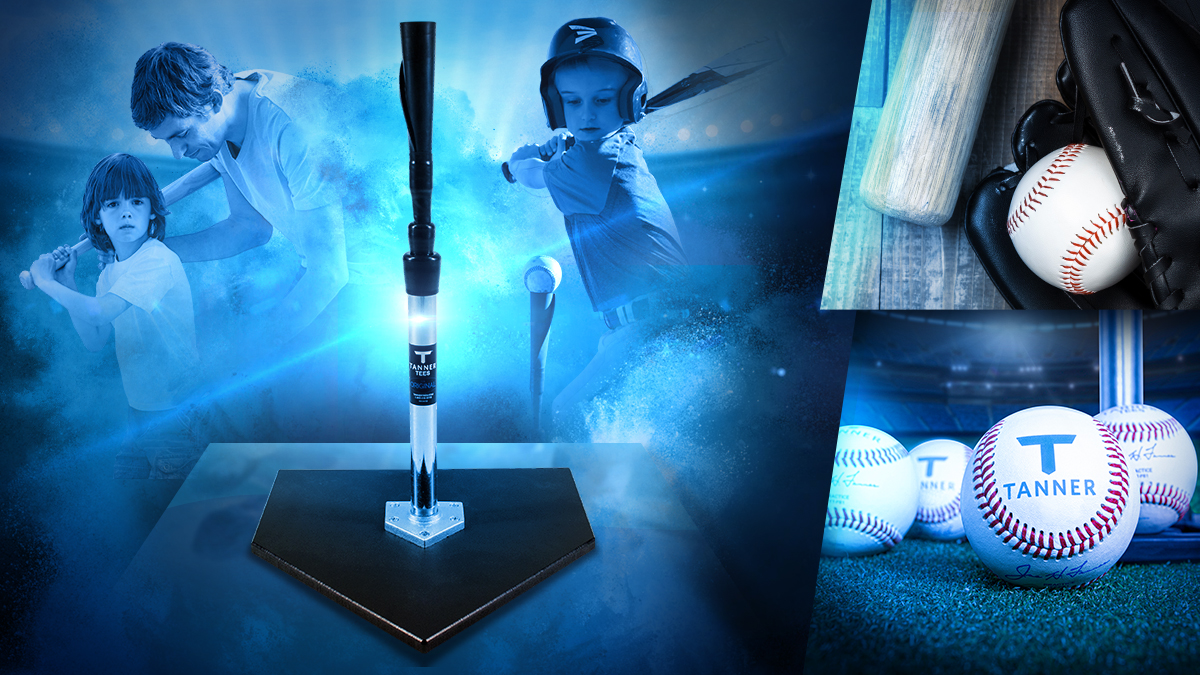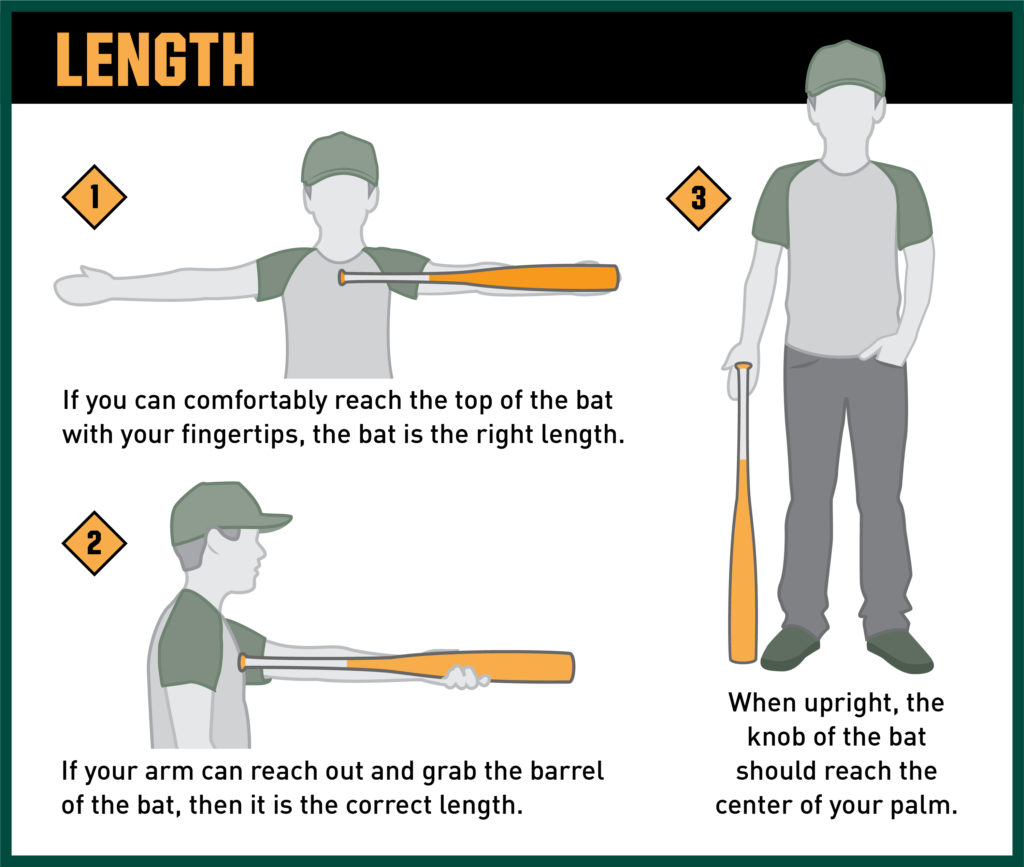How to Select the Right Baseball Bat: A Comprehensive Guide
To select the right baseball bat, consider length, weight, and material. Check league requirements and personal comfort.
Choosing the appropriate baseball bat is crucial for any player’s performance. The bat’s length should match the player’s arm span and height, enabling a comfortable swing without straining. Weight influences swing speed; a heavier bat offers power but requires greater strength, while a lighter bat increases control and agility.
Material options like aluminum, composite, or wood affect durability, performance, and often league compliance. Players should also keep in mind the bat’s barrel size and grip comfort. Ultimately, the perfect baseball bat balances individual preferences with official regulations to foster confidence and success on the field.

Credit: blog.tannertees.com
The Importance Of Choosing The Right Bat
Picking the right baseball bat is a big deal. Get it right, and you’re on track for success; get it wrong, and it’s a strike before you’ve even swung. A bat isn’t just a piece of equipment; it’s an extension of the player. The perfect bat fits not just your hands, but your playing style and the rules of the game.
Impact On Performance
The right bat can turn a good hitter into a great one. Balance, weight, and length are critical. Choose poorly, and it could mean missed shots and slow swings. But with the right bat, you’ll handle pitches like a pro. Your bat should allow for quick swings and precision hits.
- Weight: A lighter bat means quicker swings.
- Length: Reach further with a longer bat.
- Material: Wood or metal can affect the feel.
Compliance With League Regulations
The right bat doesn’t just feel good; it follows the rules too. Each league has its own guidelines. Little League, high school, and college leagues differ in what bats they allow. Check the rule book and make sure your bat is a perfect match. Using an illegal bat can lead to game penalties or disqualification.
| League | Regulations | Approved Bat Material |
|---|---|---|
| Little League | 2 1/4″ diameter max | Composite, Aluminum, Wood |
| High School | 2 5/8″ diameter max, BBCOR certified | Alloy, Composite |
| College | 2 5/8″ diameter max, BBCOR certified | Alloy, Composite, Wood |
Anatomy Of A Baseball Bat
Finding the perfect baseball bat starts with understanding its anatomy. A bat consists of three main parts: the knob, handle, and barrel. The knob keeps the bat from slipping out of your hands. The handle allows for grip and control. The barrel is where you strike the ball. The right combination of these elements ensures peak performance and comfort at the plate.
Differences Between Wood And Metal Bats
Wood bats have a classic feel, with a solid thud on contact. Preferred in professional leagues, they offer a smooth, traditional swing. Metal bats, commonly aluminum or composite, provide a lighter, faster swing and a larger sweet spot. Younger players often choose metal for its durability and power amplification.
| Wood Bats | Metal Bats |
|---|---|
| Classic feel on contact | Lightweight with a larger sweet spot |
| Used in professional leagues | Common among younger players |
| Offers a traditional swing | Amplifies power |
Weight, Length, And Barrel Considerations
Selecting the right bat also involves weight, length, and barrel size. A heavier bat offers more power, while a lighter bat provides faster swing speeds. Length impacts reach and plate coverage. For barrel size, a larger barrel delivers a more massive hitting zone. Bats are measured in ounces (weight) and inches (length).
- Weight: Heavier bats add power; lighter bats speed up swings.
- Length: Proper length is essential for optimal reach.
- Barrel: Bigger barrels provide a larger contact area.
- Determine your strength to select the weight.
- Measure your height and reach for the right length.
- Consider league rules for barrel diameter restrictions.
Know Your League: Understanding Restrictions
Choosing the right baseball bat involves more than just feeling for comfort and weight. League rules determine which bats are legal for play. Each league has specific restrictions, including material, weight, length, and diameter of the bat. Not following these guidelines can lead to disqualification. Ahead, detailed information about regulations for high school, college, and professional play is outlined.
High School And College Regulations
High school and college players must be mindful of the bat standards set by the National Federation of State High School Associations (NFHS) and the National Collegiate Athletic Association (NCAA). These organizations require that bats meet specific criteria:
- Material: Both aluminum and composite bats are permissible.
- Weight to Length Ratio: Bats must not exceed a -3 drop.
- Barrel Diameter: The maximum allowed is 2 5/8 inches.
- Certification: Bats must have a visible BBCOR stamp.
| Requirement | Details |
|---|---|
| Material | Aluminum or Composite |
| Weight/Length Ratio | Maximum -3 Drop |
| Barrel Diameter | Up to 2 5/8 inches |
| Certification | Must have BBCOR stamp |
Professional League Standards
Professional leagues, such as Major League Baseball, have their own distinct specifications. These are some of the key features:
- Material: Only solid wood bats are approved.
- Length: Bats must be no longer than 42 inches.
- Diameter: The maximum barrel size allowed is 2.61 inches.
| Feature | Specification |
|---|---|
| Material | Solid Wood |
| Length | Up to 42 inches |
| Diameter | Maximum 2.61 inches |
Always check with your coach or league officials for the most current bat regulations. Ensuring yo
ur bat meets these standards keeps gameplay fair and competitive. Equipping yourself with the right information helps in selecting an appropriate bat and avoids any inconvenience during official games.Finding Your Fit: Bat Sizing Basics
Selecting the right baseball bat is crucial for any player. The perfect bat feels like an extension of the arm, enhancing your control and power at the plate. To ensure you pick your ideal bat, understanding sizing basics is key. Let’s dive into how to find the right bat based on age, height, and weight.
Age-appropriate Bat Sizes
Finding the right bat starts with considering the player’s age. Different age groups have recommended bat lengths for optimal performance.
- T-Ball (4-6 years): 24″ to 26″
- Little League (6-10 years): 27″ to 30″
- Junior League (11-14 years): 28″ to 32″
- High School & Beyond (15+ years): 31″ to 34″
Height And Weight Sizing Chart
Your height and weight significantly influence bat choice. Match your measurements for tailored sizing.
| Height | Weight | Recommended Bat Length |
|---|---|---|
| < 4′ | < 60 lbs | 28″ to 29″ |
| 4’1″ to 4’4″ | 60-90 lbs | 29″ to 30″ |
| 4’5″ to 4’8″ | 91-110 lbs | 30″ to 31″ |
| 4’9″ to 5′ | 111-130 lbs | 31″ to 32″ |
| 5’1″ to 5’4″ | 131-150 lbs | 32″ to 33″ |
| 5’5″ to 5’8″ | 151-180 lbs | 33″ to 34″ |
| 5’9″ to 6′ | 181-210 lbs | 34″ |
| > 6′ | > 210 lbs | 34″ |
Remember: These are general guidelines. Players may prefer a different bat length based on personal comfort. Always swing a few bats to see what feels best before making a decision.
Weight Matters: Balancing Bat Heft And Swing Speed
Choosing the perfect baseball bat is crucial for any player. A bat’s weight can greatly affect a player’s swing speed and overall performance. Players need a bat that feels comfortable to hold, easy to swing, and powerful on contact. Knowing how to find that balance between bat heft and swing speed allows players to step up to the plate with confidence.
How To Test Swing Weight
Finding the right swing weight starts with a simple test. Players should hold the bat with one hand at the bottom of the grip and try to swing it. If they can maintain control without straining their wrists, the weight might be a good fit. Trying different bats during practice helps determine which ones feel like an extension of the arm.
- Hold the bat with one hand
- Swing it horizontally
- Assess comfort and control
- Repeat with various weights
The Role Of Bat Drop In Selecting The Right Bat
Bat ‘drop’ is the difference between the length of the bat in inches and the weight in ounces. A higher bat drop means a lighter bat, which can lead to faster swing speeds. Younger or smaller players often benefit from a higher bat drop to enhance their swing. Conversely, heavier bats with lower drops provide more power but can slow a player’s swing.
| Bat Length (inches) | Weight (ounces) | Bat Drop |
|---|---|---|
| 30 | 20 | -10 |
| 32 | 29 | -3 |
Select the right bat drop with these steps:
- Measure your height and weight
- Refer to a bat size chart
- Test different bat drops
- Choose comfort over trends
Material Makeup: Pros And Cons
Finding the perfect baseball bat starts with understanding the material. Each material offers unique benefits and drawbacks. The choice can impact your swing, comfort, and overall performance. It’s important to weigh these factors carefully. Let’s break down the materials to find your ideal bat.
Alloy Versus Composite Bats
Alloy bats, often made from aluminum, are ready to use without any break-in time. They’re usually lighter, which can lead to a faster swing speed. The sound of an alloy bat connecting with a ball is unmistakable – a clear and satisfying ‘ping’.
Composite bats, on the other hand, shine in their reduced vibration and larger sweet spot. They require a break-in period to reach optimal performance. These bats also tend to be pricier than their alloy counterparts.
| Material | Pros | Cons |
|---|---|---|
| Alloy |
|
|
| Composite |
|
|
Traditional Wood Bat Selection
Wood bats carry a classic feel, and many players prefer their natural feedback. They’re excellent for honing your batting skills, as they require precise contact for maximum performance. You’ll mostly find ash, maple, and birch bats.
| Wood Type | Pros | Cons |
|---|---|---|
| Ash |
|
|
| Maple |
|
|
| Birch |
|
|
Grip And Comfort: Customizing Your Handle
Finding the right baseball bat is a key step for any player. The handle’s grip and comfort can greatly affect your swing and overall performance. By customizing your bat’s handle, you can enhance control, reduce hand fatigue, and improve the feel of the bat during a swing.
Types Of Grips And Tapes
Choosing the right type of grip is essential for a good hold. Here are common options:
- Synthetic grips: They offer durability and come in varied thicknesses.
- Leather grips: These provide a traditional feel and assist with moisture absorption.
- Camouflage grips: They are not just for looks; they offer a good blend of grip and cushion.
- Chamois grips: Best for players who prefer a soft, tacky touch to hold onto during at-bats.
Tape customization also affects grip:
| Tape Type | Benefits | Ideal For |
|---|---|---|
| Polymer Bat Tape | Durability, vibration reduction | Long-term use |
| Grip Tape | Better hold, shock absorption | Hitters seeking comfort |
| Tacky Tape | Improved control and feel | Batters in humid conditions |
Ergonomic Considerations For Batters
Ergonomics plays a vital role in ensuring you have the best batting experience. The handle should feel natural in your hands, offering a balance between cushion and firmness.
Consider these points:
- Diameter: Select a handle that allows for a comfortable and secure grip.
- Texture: Opt for a texture that prevents slipping without causing discomfort.
- Weight: Heavier tapes may affect the swing weight but also provide more cushioning.
Remember, a grip tailored to your needs will not only provide comfort but can also elevate your game. Be sure to take into account the grip type, tape material, and ergonomic design when selecting your baseball bat handle.

Credit: www.dickssportinggoods.com
Brand And Budget: Making A Cost-effective Choice
Selecting the right baseball bat involves balancing brand reputation and budget constraints. Not all bats are created equal, and navigating through the myriad of options can be overwhelming. Whether you’re stepping up to the plate in little league or hitting in a college tournament, discovering a bat that meets both your financial means and your playing needs is key.
Popular Baseball Bat Brands
Knowing the leading names in the baseball bat market sets the stage for a well-informed purchase. Brands like Easton, Louisville Slugger, and DeMarini often come recommended by coaches and experienced players alike.
| Brand | Target Player | Price Range |
|---|---|---|
| Easton | Beginners to Professionals | $$ – $$$$ |
| Louisville Slugger | Amateurs to Pros | $$$ – $$$$ |
| DeMarini | Juniors to Professionals | $$ – $$$$ |
Investing Wisely For Durability And Performance
It’s not just about picking any bat off the shelf. Investing in quality ensures longevity. Bats with a reputation for durability offer more plate appearances over their lifecycle. Consider materials like aluminum or composite, which are known for their resilience. Look out for warranty offerings—they speak volumes about a bat’s quality.
- Aluminum bats – lightweight and strong
- Composite bats – flexible with a larger sweet spot
- Hybrid bats – combine the best of both worlds
Checking reviews and ratings can guide your budget-wise decision. A bat that stands the test of time without breaking the bank is a home run for any player.
Testing The Bats: Practice Makes Perfect
Choosing the right baseball bat might seem daunting. Testing different bats in practice is a surefire way to find the perfect match. Feel the swing, hear the hit, and notice how each bat performs. Only through hands-on experience can you truly know which bat suits your playing style best.
Demo Days And Bat Trials
Most sports shops and manufacturers understand the importance of finding the right fit. That’s why demo days are so valuable. Here, you can swing a variety of bats and receive instant feedback about how each one feels in your hands.
- Test different weight options
- Feel the grip and balance
- Assess the contact sound
Look for local bat trial events at your nearest sports complex. These events let you test bats during real practice sessions.
Feedback From Coaches And Players
Listening to feedback is crucial. Coaches often see what you might miss. Peers provide insights based on their experiences. This collective wisdom aids in making an informed choice.
| Source | Type of feedback | Benefit to Player |
|---|---|---|
| Coaches | Technical | Improves technique |
| Players | Personal Experience | Relates to player’s needs |
Always consider multiple points of view when collecting feedback. Balance what you feel with what you’re told for the best decision.

Credit: kratosports.com
Care And Maintenance: Extending Bat Longevity
Treat your baseball bat right, and it will hit home runs for seasons to come. Regular care and proper maintenance are key. These steps make sure your bat stays in top shape. This section covers proper storage and routine cleaning. Let’s keep that bat swinging strong.
Proper Storage Practices
Good storage keeps a bat safe and sound. Follow these tips:
- Avoid extreme temperatures. Store bats in a cool, dry place.
- Keep bats horizontal or in a rack. This prevents warping.
- Separate bats from heavy gear. This avoids dents and scratches.
Routine Cleaning And Inspection Tips
Dirty bats can degrade. Check and clean often to extend lifespan. Give your bat regular love with these steps:
- Wipe it down. Use a soft cloth after each use.
- Check for damage. Look for dents or cracks often.
- Keep it dry. Remove moisture to prevent mildew and warping.
Frequently Asked Questions On How To Select The Right Baseball Bat
How Do I Choose The Right Baseball Bat?
Consider the league’s bat requirements, choose a length and weight that complement your size and strength, select a material (aluminum or composite for durability and power), and finally, think about the bat’s barrel size for the sweet spot. Always try swinging different bats before purchasing.
How Do You Know If A Bat Is Right For You?
To determine if a bat is right for you, assess the weight, length, comfort in your grip, and match to your league’s requirements. Also, the bat should feel balanced and enable a smooth swing.
How Do I Know What Drop Bat I Need?
Choose a drop bat based on your size, strength, and hitting style. Lighter drop weights aid swing speed, while heavier bats offer power. Consult league regulations for restrictions, and try different bats for comfort and performance before purchase.
Conclusion
Selecting the right baseball bat greatly impacts your game. Balance comfort, material, and length with your unique style. Remember, the perfect bat enhances swing, precision, and confidence. Keep these tips in mind, and step up to the plate ready to hit a home run every time.
Swing for the fences!



